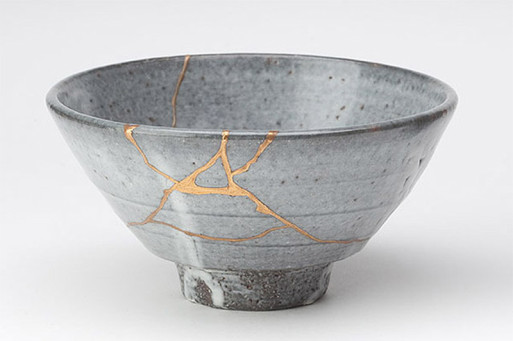
A kintsugi bowl
(Credit: thisiscolossal.com)
The 15th century Japanese art of “Kintsugi” (golden joinery) or “Kintsukuroi” (golden repair) involves the mending of shattered ceramics with “urushi” lacquer and powdered metal — most commonly gold. The central philosophy of Kintsugi is that an object is made more beautiful by its history; when it is broken through time and usage, it accumulates a story. The name for this aesthetic philosophy and worldview is wabi-sabi: finding beauty in that which is imperfect, incomplete, impermanent, and marked by time. Under the skillful hands of a Kintsugi artist, a broken ceramic is transformed, through careful attention into something more beautiful than it was before.
Kintsugi: The Art of Broken Pieces featuring artists Muneaki Shimode and Takahiko Sato
Artist TJ Volonis evocatively expresses how Kintsugi can help us come to terms with human mortality in his 2015 exhibit Pagan Poetry, which featured several ceramic works mended with urushi lacquer. The sculpture “Repaired Heart” leaves little doubt that a broken heart becomes more beautiful when it is treated as something precious, tended with concentration and care.

REPAIRED HEART (KINTSUGI STUDY, #4) 2015 by TJ Volonis
(Credit: vanderbiltrepublic.com)
Kintsugi demands of the beauty-seeker that they be comfortable with impermanence and the feeling of groundless that attends it. This groundlessness is a kind of hopelessness — a relinquishing of resistance to the present moment when it is not going the way we desire. American Buddhist nun Pema Chödrön writes in her book “When Things Fall Apart: Heart Advice for Difficult Times,” “If we totally experience hopelessness, giving up all hope of alternatives to the present moment,” we can “have a joyful relationship with our lives, an honest, direct relationship — one that no longer ignores the realities of impermanence and death.” Kintsugi is therefore a meditation upon the transience of human life, which is no less valuable or beautiful for being so brief.

 Kintsugi: Finding Beauty in Brokenness
Kintsugi: Finding Beauty in Brokenness


 Our Monthly Tip: Make an “In Case of Death” File to Ease Loved One’s Grief
Our Monthly Tip: Make an “In Case of Death” File to Ease Loved One’s Grief
 Passing of Beloved Comedian Births a New Comedy Festival
Passing of Beloved Comedian Births a New Comedy Festival















